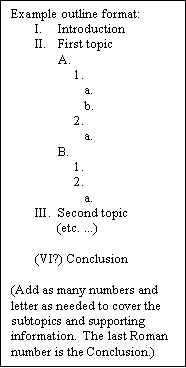Writing an Outline: Organizing Your Paper
Outlining the flow of information in your paper is the first step to clarity in writing. To make an outline, a writer lists the subtopics he/she has to explain toanswer the final research question. However, during the research process new information often changes the subtopics that eventually make up the paper. The outline helps you get rid of excess information and organize what is left.
To create anoutline, list the introduction, the major sections (subtopics), and the conclusion with Roman numerals (I, II, III, etc.). Then below each section, list the basic information categories with capital letters (A, B, C, etc.). Just use phrases, not sentences, to indicate the information you will cover; it should be a guide to the information for each paragraph. Below these letters, list the individual facts and supporting comments from sources as small letters (a, b, c, etc.), or break them down even further by listing key ideas, quotes, etc. as numbers (1, 2, 3, etc.) below the small letters.
HINT: Some writers find it helpful to use the outline as a guide for which sources will be used under each point. Add the authors’ names or some other notation next to each point on your outline to show where the information will come from. Some teachers do not require a detailed outline, but creating at least a general one will help you focus on what information you have and what you still need to learn as you go on to write your paper.
